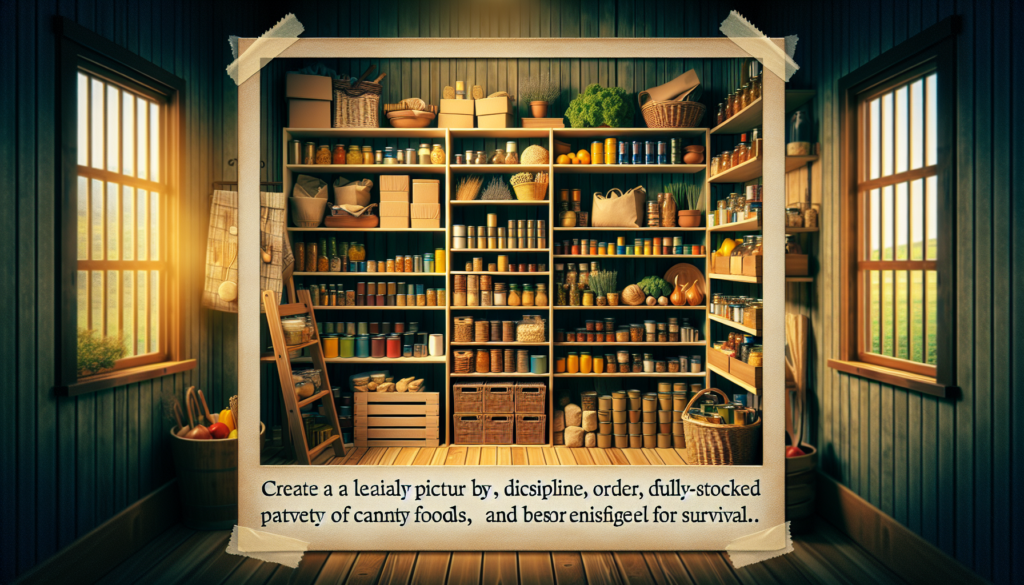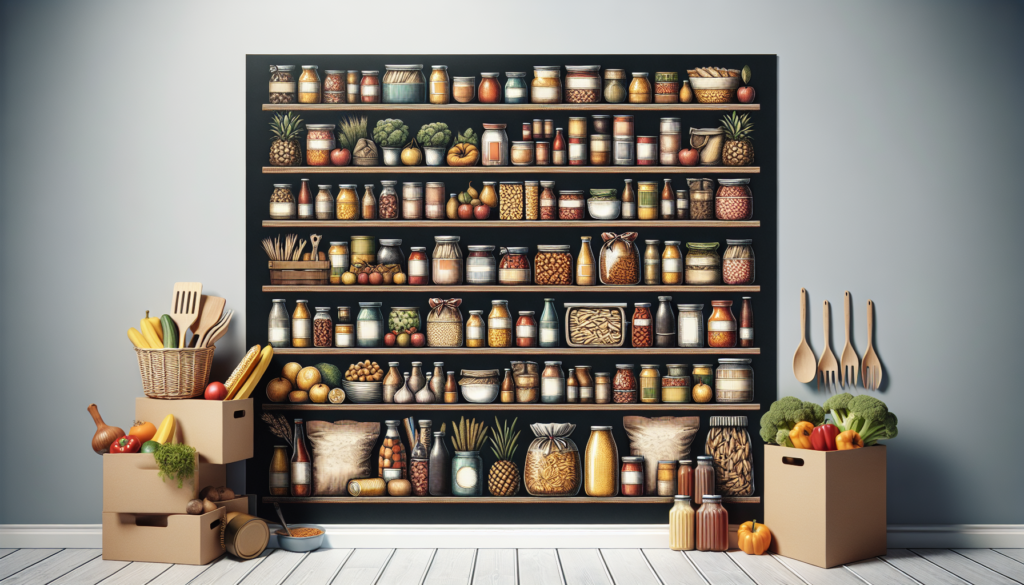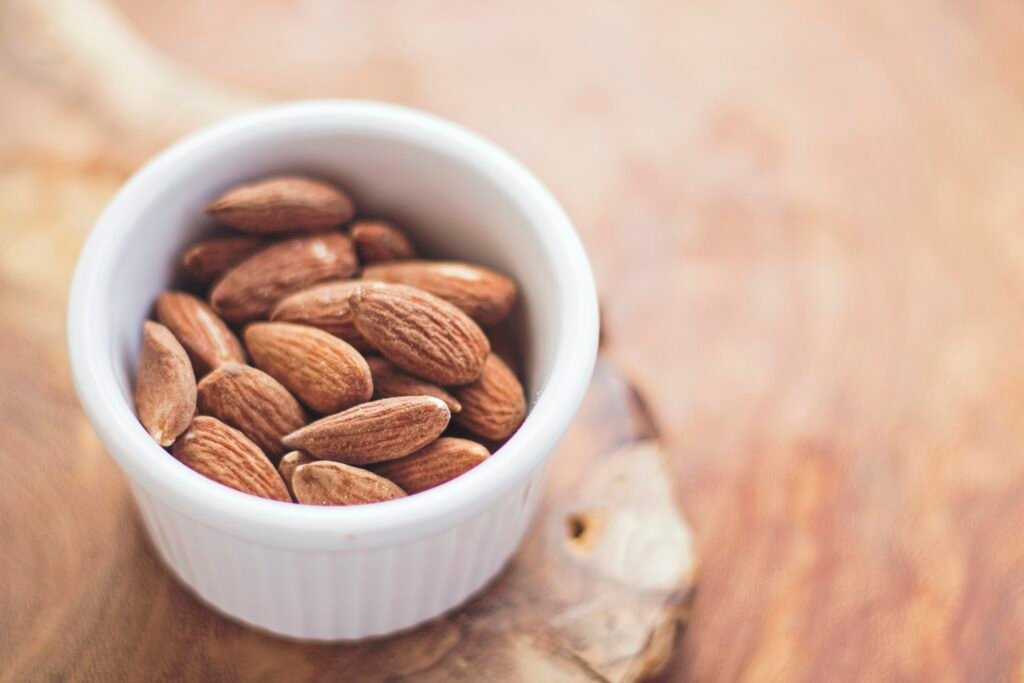In a world where being prepared is increasingly important, knowing how to properly store food for long-term survival is a key skill to have. Whether you’re a seasoned survivalist or just starting your journey, these tips will help ensure that your food remains fresh, nutritious, and ready to sustain you during any crisis. From choosing the right containers to managing temperatures, we’ll guide you through the essential steps to safeguard your food supply for the long haul. So, grab a pen and paper, it’s time to learn how to become a food storage pro!

Selecting the Right Storage Location
Consider the Environmental Factors
When selecting a storage location for your food items, it is important to consider the environmental factors that can affect their longevity. Extreme temperatures, humidity, and exposure to light can all play a role in how quickly your food spoils. Look for a place in your home that is relatively cool, dry, and protected from direct sunlight. This will help create an optimal environment for long-term food storage.
Choose a Cool and Dark Location
A cool and dark location is ideal for storing food items, as it helps to maintain a stable temperature and limits exposure to light. High temperatures can accelerate the degradation of food, while sunlight can cause the breakdown of certain vitamins and nutrients. Look for a pantry, basement, or any other area in your home that is consistently cool and dark to ensure the longevity of your stored food.
Ensure Proper Ventilation
While it is important to select a cool and dark location for your food storage, it is equally important to ensure proper ventilation. Proper airflow helps to prevent the buildup of moisture, which can lead to the growth of mold and the spoilage of your food. Make sure to choose a storage location that allows for airflow and consider using fans or dehumidifiers if necessary to maintain the right moisture levels.
Choosing Suitable Containers
Opt for Air-tight Containers
When it comes to storing food for long-term survival, one of the most important considerations is the container in which it is stored. Opt for air-tight containers, such as food-grade buckets with sturdy lids or vacuum-sealed bags. These types of containers create a barrier against moisture, pests, and oxygen, which can all contribute to the deterioration of your food.
Use BPA-free Plastic Containers
If you choose to use plastic containers for your food storage, it is essential to select BPA-free options. Bisphenol A (BPA) is a chemical commonly found in certain plastics and can leach into your food over time. BPA has been linked to various health issues, so it is best to choose containers labeled as BPA-free to ensure the safety of your stored food.
Consider Glass Jars
Glass jars are another excellent option for storing food. They are non-toxic, durable, and do not interact with the contents stored inside. Glass jars also provide a clear view of the contents, making it easy to identify what you have stored. However, it is important to note that glass jars are more prone to breakage, so handle them with care when moving or transporting.
Avoid Using Cardboard Boxes
While cardboard boxes may seem convenient for storing food, they are not the best long-term solution. Cardboard is prone to absorbing moisture, which can lead to the growth of mold and the deterioration of your food. Additionally, pests such as rodents and insects can easily chew through cardboard, causing contamination. It is best to avoid using cardboard boxes and opt for more secure and durable containers instead.

Storing Dry Goods
Properly Seal Dry Goods
When storing dry goods such as grains, beans, and pasta, it is crucial to properly seal them to prevent moisture from entering, which can lead to spoilage and the growth of mold. Use air-tight containers or bags and make sure to remove as much air as possible before sealing. This will help maintain the freshness and quality of your dry goods over an extended period.
Utilize Mylar Bags and Oxygen Absorbers
For optimal long-term storage of dry goods, consider using Mylar bags along with oxygen absorbers. Mylar bags are made from a material that provides an additional layer of protection against moisture, pests, and oxygen. Oxygen absorbers, on the other hand, help remove any remaining oxygen inside the bags, further reducing the risk of spoilage and extending the shelf life of your dry goods.
Label and Track Your Inventory
To effectively manage your food storage, it is essential to label and track your inventory of dry goods. Clearly label each container or bag with the contents and the date of storage. This will help you easily identify and rotate your stock, ensuring that you consume the oldest items first. Keeping track of your inventory will also help you avoid duplicate purchases and efficient meal planning.
Preserving Canned Foods
Inspect and Verify Canned Food Integrity
Before storing canned foods for long-term survival, it is vital to inspect each can to ensure its integrity. Check for any signs of damage, such as bulging lids or rust, as this can indicate a compromised seal or potential contamination. If you notice any issues, it is best to discard the can as consuming spoiled or contaminated food can be harmful.
Store Canned Foods in a Cool Area
To maintain the quality and taste of canned foods, store them in a cool area away from direct sunlight. Canned foods are generally heat-processed during manufacturing, which provides a longer shelf life. However, exposure to high temperatures can still affect the overall quality and nutritional value of the contents. Therefore, it is best to choose a cool and dark location for the storage of canned goods.
Rotate Canned Goods for Freshness
Similar to dry goods, it is important to implement a rotating system for canned goods to ensure freshness. Use the First-In, First-Out (FIFO) principle, where you consume the oldest cans first and replenish your stock with new ones. This will help avoid the accumulation of expired canned goods and ensure that you always have a fresh supply on hand.

This image is property of images.unsplash.com.
Freezing Foods for Long-Term Storage
Choose Foods Suitable for Freezing
Freezing is an effective method for long-term food storage, but not all foods are suitable for freezing. Some foods, such as lettuce, cucumbers, and citrus fruits, do not freeze well and can lose their texture and taste. Choose foods that are known to freeze well, such as meat, poultry, fish, vegetables, and fruits that are suitable for freezing.
Package Foods Correctly
Properly packaging foods is crucial when freezing them for long-term storage. Use air-tight freezer bags or containers to prevent freezer burn and the absorption of odors. Remove as much air as possible from the bags to maintain the quality of the food. For liquids, leave some headspace to allow for expansion during freezing.
Label and Date Frozen Items
To avoid confusion and ensure proper rotation, always label and date your frozen items. Include the contents and the date of freezing on the package. This information will help you easily identify what you have and how long it has been stored. Additionally, using clear labels will allow you to quickly locate the items you need without having to thaw everything.
Maintain Constant Freezer Temperature
To maintain the quality and freshness of frozen foods, it is important to maintain a constant freezer temperature. Fluctuations in temperature can lead to freezer burn and affect the overall texture and taste of the food. Keep the freezer temperature at or below 0°F (-18°C) and avoid frequent opening of the freezer door to ensure a stable environment.
Storing Fresh Fruits and Vegetables
Sort and Remove Damaged Produce
Before storing fresh fruits and vegetables, sort through your produce and remove any damaged or rotten pieces. Damaged produce can cause the surrounding fruits or vegetables to spoil faster, so it is best to discard them. Properly sort and inspect your produce to ensure that only the fresh and healthy items are stored.
Know Which Produce Requires Refrigeration
Not all fruits and vegetables require refrigeration, and storing them in the wrong conditions can lead to spoilage. Some fruits, such as apples, berries, and citrus fruits, should be stored in the refrigerator to maintain their freshness. On the other hand, tomatoes, potatoes, onions, and bananas are typically stored at room temperature. Familiarize yourself with the optimal storage conditions for different types of produce to maximize their shelf life.
Utilize the Right Storage Containers
Using the right storage containers for fresh fruits and vegetables can help prolong their freshness. Opt for breathable containers or bags that allow some airflow while still providing protection against moisture and pests. For leafy greens, consider using salad spinners or produce storage bags that help maintain their crispness. Avoid tight plastic bags or containers that trap too much moisture and can lead to rotting.
Store Different Produce Separately
To prevent the ripening of one type of produce from affecting others, it is best to store different fruits and vegetables separately. Some fruits, such as apples and bananas, produce ethylene gas as they ripen, which can accelerate the ripening process of other produce. Keep ethylene-producing fruits away from ethylene-sensitive ones to maintain their quality and freshness for a longer period.

This image is property of images.unsplash.com.
Keeping Dairy and Eggs Safely
Understand Dairy and Egg Shelf Life
Dairy products and eggs have varying shelf lives, and it is important to understand how long they can be safely stored. Milk and soft dairy products, such as yogurt and cottage cheese, generally have a shorter shelf life and should be consumed within their expiration dates. Hard cheeses and butter, on the other hand, can typically be stored for longer periods. Eggs can be stored in the refrigerator for several weeks but should be consumed promptly once cracked.
Store Dairy Products in the Coldest Section of the Refrigerator
To maintain the quality and freshness of dairy products, store them in the coldest section of the refrigerator, usually the back. This area experiences the least temperature fluctuations and provides the most optimal conditions for keeping dairy items. Make sure to push other items aside to ensure proper airflow around the dairy products and prevent cross-contamination.
Keep Eggs in Their Original Cartons
Eggs should be kept in their original cartons when storing them in the refrigerator. The cartons provide protection against light and help maintain a more stable temperature. Avoid transferring eggs to other containers or storing them on the refrigerator door, as this area is subject to temperature fluctuations due to frequent opening and closing.
Consider Freezing Dairy and Eggs if Necessary
If you find yourself with excess dairy or eggs that you know you will not be able to use before they spoil, consider freezing them. Dairy products such as milk, cheese, and butter can be frozen and used later in cooking or baking. Eggs can also be frozen, but it is best to remove them from the shells and beat them before freezing. Frozen dairy and eggs can lose some of their original texture but can still be safely consumed.
Maintaining Proper Spices and Condiments Storage
Keep Spices and Condiments in Airtight Containers
Proper storage of spices and condiments is essential for maintaining their flavor and potency. Keep spices and condiments in airtight containers to protect them from moisture, which can cause clumping or loss of flavor. Use small glass jars or plastic containers with tight lids to prevent air and humidity from degrading the quality of your spices and condiments.
Store in a Cool, Dry, and Dark Place
To prolong the shelf life of spices and condiments, store them in a cool, dry, and dark place. Exposure to heat, light, and moisture can cause spices to lose their flavor and condiments to spoil. Avoid storing spices and condiments near the stove, dishwasher, or other areas with high heat and humidity. Instead, choose a pantry or cabinet away from direct sunlight and sources of moisture.

This image is property of images.unsplash.com.
Storing Meat and Seafood
Keep Meat and Seafood Fresh Before Storage
Before storing meat and seafood, it is important to ensure that they are fresh to begin with. Purchase from reputable sources and check for any signs of spoilage or damage. Meat should be kept at a safe temperature (below 40°F or 4°C) until ready to be stored, and seafood should be properly cleaned and stored on ice if not consumed immediately.
Use Vacuum Sealing for Extended Storage
One of the most effective methods of storing meat and seafood for long periods is vacuum sealing. Vacuum sealing removes air from the packaging, which helps prevent freezer burn and slows down the oxidation process. This significantly extends the shelf life of meat and seafood, allowing you to enjoy them even after months of storage.
Monitor and Maintain Safe Temperatures
To ensure the safety and quality of stored meat and seafood, it is crucial to monitor and maintain safe temperatures throughout the storage process. Keep your refrigerator at or below 40°F (4°C) and your freezer at 0°F (-18°C) or below. Regularly check and calibrate your appliances’ temperature settings to ensure they are functioning properly. Additionally, if there is a power outage, try to minimize opening the refrigerator or freezer doors to maintain the cold temperature as much as possible.
Rotating and Managing Food Inventory
Implement First-In, First-Out (FIFO) Principle
Implementing the First-In, First-Out (FIFO) principle is crucial for managing and rotating your food inventory. This means consuming the oldest items first and constantly replenishing your stock with newer items. By doing so, you can minimize waste and ensure that your stored food remains fresh and safe for consumption.
Regularly Check and Evaluate Food Stock
Regularly check your food stock to ensure that everything remains in good condition and has not expired. Inspect containers, packages, and cans for any signs of damage or spoilage. Evaluate the quality and freshness of the items to make informed decisions on what to consume next and what needs to be replaced.
Create a System for Tracking Expiration Dates
To effectively manage your food inventory, create a system for tracking expiration dates. This can be as simple as using a marker to write the expiry dates on the containers or utilizing a spreadsheet to keep track of the dates digitally. By keeping track of expiration dates, you can easily identify and remove any expired items from your storage, reducing the risk of consuming spoiled food.
Properly storing food for long-term survival is crucial for ensuring that you have a readily available and safe food supply. By selecting the right storage location, choosing suitable containers, and implementing appropriate storage methods for different types of food, you can extend the shelf life of your stored items and be better prepared for any unforeseen circumstances. Remember to regularly check and rotate your food inventory to maintain freshness and to properly manage your stock. With these tips in mind, you can confidently store food for long-term survival and have peace of mind knowing that you are well-prepared.